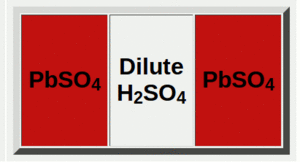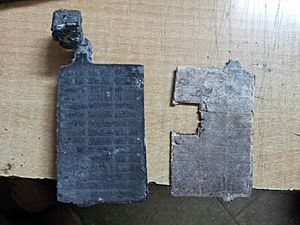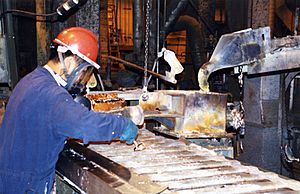Lead–acid battery facts for kids
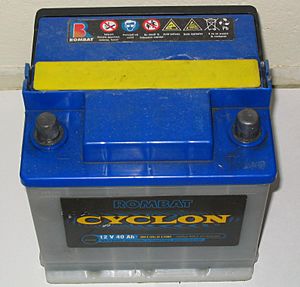
12v lead–acid car battery
|
|
| Specific energy | 35–40 Wh/kg |
|---|---|
| Energy density | 80–90 Wh/L |
| Specific power | 180 W/kg |
| Charge/discharge efficiency | 50%–95% |
| Energy/consumer-price | 7 (sld) to 18 (fld) Wh/US$ |
| Self-discharge rate | 3%–20%/month |
| Cycle durability | <350 cycles |
| Nominal cell voltage | 2.1 V |
| Charge temperature interval | Min. −35°C, max. 45°C |
The lead–acid battery is a special type of rechargeable battery. It was first invented in 1859 by a French scientist named Gaston Planté. This was the very first rechargeable battery ever made!
Compared to newer batteries, lead–acid batteries don't store as much energy for their size. But they are great at giving out a lot of power very quickly. This makes them perfect for starting car engines. They are also not very expensive.
Because they are cheap, lead–acid batteries are used a lot. They provide backup power for places like cell phone towers and hospitals. They also power homes that are not connected to the main electricity grid. Some types, like gel-cells and absorbed glass-mat (AGM) batteries, are sealed. These are called VRLA batteries.
When a lead-acid battery is charged, its energy is stored. This happens between a metal called lead and another material called lead dioxide.
Contents
- History of Lead-Acid Batteries
- How Lead-Acid Batteries Work
- Checking a Battery's Charge Level
- How Lead-Acid Batteries Are Made
- Where Lead-Acid Batteries Are Used
- Battery Cycles: Starting vs. Deep-Cycle
- Sulfation: A Battery Problem
- Stratification: Another Battery Problem
- Risk of Explosion
- Environmental Concerns and Recycling
- Battery Additives
- Corrosion Problems
- See also
History of Lead-Acid Batteries
In 1801, a scientist named Nicolas Gautherot noticed something interesting. Wires used for experiments could make a small electric current afterward. Then, in 1859, Gaston Planté created the first battery that could be recharged. He did this by sending electricity back through it.
Planté's first battery was made of two lead sheets. They were separated by rubber strips and rolled up like a scroll. These batteries were first used to light up train carriages when trains stopped. In 1881, Camille Alphonse Faure made an even better design. He used a lead grid filled with a lead oxide paste. This made batteries much easier to build in large numbers.
Later, in the 1930s, gel batteries were invented. These batteries use a gel instead of a liquid inside. This means they won't leak, so you can use them in different positions. In the 1970s, the sealed VRLA batteries were developed. These include modern AGM types. They can work in any position without spilling.
How Lead-Acid Batteries Work
What Happens When a Battery Discharges?
When a lead-acid battery is used (discharges), its plates change. Both the positive and negative plates turn into a material called lead(II) sulfate. The liquid inside, called the electrolyte, becomes mostly water. This is because the sulfuric acid in it gets used up.
The lead plate gives off electrons. This makes it negatively charged. At the same time, the lead dioxide plate takes in electrons. This creates the electricity that powers things.
The overall process turns lead and lead dioxide into lead sulfate. It also turns sulfuric acid into water. This reaction creates the electrical energy.
How a Battery Recharges
When you charge a lead-acid battery, the opposite happens. The lead sulfate on the plates changes back. The negative plate becomes pure lead again. The positive plate turns back into lead dioxide. The liquid inside (electrolyte) gets more sulfuric acid. This is where the battery stores its energy.
If you charge a battery too much, it can make oxygen and hydrogen gas. These gases bubble out of the battery. Some lead-acid batteries let you add pure water to replace what's lost.
Freezing and Battery Charge
If a battery has a low charge, it has less sulfuric acid. This means the liquid inside can freeze more easily in cold weather. A fully charged battery is less likely to freeze.
How Ions Move Inside the Battery
When a battery works, tiny charged particles called ions move around. During discharge, hydrogen ions move to the positive plate. During charging, they move back. This movement helps the battery create and store electricity. The liquid inside also moves around, which helps the battery work better.
Checking a Battery's Charge Level

One cool thing about lead-acid batteries is how easy it is to check their charge. You can measure the specific gravity of the electrolyte. This is how dense the liquid is. As the battery loses charge, the specific gravity goes down.
Some batteries even have a simple tool called a hydrometer. It has colored balls that float. How they float tells you how much charge is left. In old submarines, they used to measure this to know how long they could stay underwater!
You can also check the battery's voltage. A fully charged lead-acid cell usually has about 2.1 volts. A 12-volt car battery has six of these cells connected together.
How Lead-Acid Batteries Are Made
Battery Plates
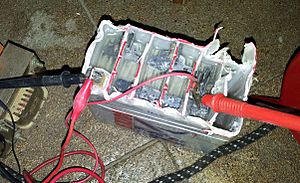
Early lead-acid batteries used simple lead sheets. But these didn't make much power. Gaston Planté found a way to make the plates have a much larger surface area. He rolled up lead foil with cloth in between. This made the batteries work better.
Later, Camille Alphonse Faure found an even better way. He coated a lead grid with a special paste. This made batteries much faster and cheaper to produce. This method is still used today!
Modern battery plates are designed to be strong and let electricity flow well. They often use lead mixed with other metals like antimony or calcium. These mixtures make the plates stronger and last longer.
Modern Plate Materials
Today's battery paste has special ingredients. These include carbon black and barium sulfate. These help the battery work better and last longer. They make sure the materials on the plates can easily change back and forth during charging and discharging.
Once the plates are dry, they are stacked inside a container. Thin sheets called separators are placed between them. These separators stop the plates from touching and causing a short circuit. They also let ions move between the plates.
Absorbent Glass Mat (AGM) Batteries
In AGM batteries, the separators are made of a glass fibre mat. This mat is soaked in the electrolyte. There's just enough liquid to keep the mat wet. If the battery case breaks, the liquid won't spill out.
AGM batteries are sealed. This means gases produced inside can recombine into water. This stops the battery from drying out quickly. They also have a special valve to release pressure if needed. This is why they are called "valve-regulated."
Another good thing about AGM batteries is that the mat holds the plates tightly. This makes them stronger and helps them store more energy for their size. Also, the mat stops the liquid from separating into layers. This helps the battery last longer and work better in cold weather.
Gel Batteries
Gel batteries were developed in the 1970s. They mix a special gelling agent into the electrolyte. This turns the liquid inside into a thick paste. Like AGM batteries, gel batteries are sealed and don't need water added. They are also good in very hot or cold conditions.
The only small drawback is that the gel makes it harder for ions to move quickly. So, gel batteries are not as good at giving a huge burst of power. They are often used for storing energy over longer periods, like in off-grid systems.
"Maintenance-Free" Batteries
Both gel and AGM batteries are sealed and don't need regular watering. They can also be used in any direction. Because of this, they are often called "maintenance-free" or "sealed" batteries. However, they still need some care. Over time, they can lose some liquid and capacity. Checking their internal resistance can help you know if they need attention.
VRLA batteries became popular for motorcycles in the 1980s. This is because the acid won't spill. They also handle vibrations better.
Where Lead-Acid Batteries Are Used
Most lead-acid batteries are used in cars for starting the engine, lights, and ignition (SLI). Millions of these batteries are made every year.
Large lead-acid batteries are also used for backup power. They power telephone and computer centers. They store energy for homes not connected to the main power grid. They are also used in emergency lighting and for sump pumps during power outages.
Traction batteries power things like golf carts and other battery electric vehicles. Big lead-acid batteries power electric motors in diesel-electric submarines when they are underwater. They are also emergency power for nuclear submarines.
Sealed VRLA batteries are used in back-up power for alarms and small computer systems. They are also found in electric scooters, wheelchairs, electrified bicycles, and motorcycles. Many electric forklifts use them too. The battery's weight even helps balance the forklift!
Battery Cycles: Starting vs. Deep-Cycle
Starting Batteries
Batteries made for starting car engines are not meant to be deeply discharged. They have many thin plates to give a lot of power quickly. But if you drain them too much, the plates can get damaged. This makes the battery lose power and fail early.
Starting batteries are lighter than deep-cycle batteries of the same size. Their plates don't go all the way to the bottom. This lets any loose material fall off the plates. This helps the battery last longer.
Deep-Cycle Batteries
Deep-cycle batteries are built differently. They can be discharged many times without getting damaged. They are used in things like photovoltaic (solar) systems and electric vehicles.
These batteries have thicker plates. They give less peak current (less power all at once). But they can handle being discharged often.
Some batteries are a mix of both. They are called "marine/motorhome" or "leisure" batteries. They can be discharged more than car batteries, but not as much as true deep-cycle ones.
Charging and Discharging Speed
How much power a lead-acid battery can give depends on how fast it's used. This is explained by something called Peukert's law.
When you charge or discharge a battery, the chemicals at the surface of the plates react first. Over time, this charge spreads deeper into the plates. If you charge a dead battery very quickly, only the surface might charge. The battery might seem full, but it won't last long. It needs time for the charge to spread.
Sulfation: A Battery Problem
Lead-acid batteries can lose their ability to charge if they stay discharged for too long. This problem is called sulfation. It happens when lead sulfate forms hard crystals on the plates.
Normally, lead sulfate is soft and easily changes back when the battery recharges. But if a battery is not fully charged often, some lead sulfate turns into a hard, stable form. This hard lead sulfate doesn't change back. It builds up on the plates. This means less active material is available to create electricity.
Sulfation makes it hard to recharge the battery. The sulfate deposits can even crack the plates. Batteries with sulfation have high internal resistance. They can't give much power. They also take longer to charge and get hotter.
You can often see a white coating on the plates of a sulfated battery.
To avoid sulfation, always fully recharge your battery right after using it. There's no proven way to reverse severe sulfation. So, preventing it is the best way to keep your battery healthy.
Stratification: Another Battery Problem
A lead-acid battery contains a mix of water and acid. Sulfuric acid is heavier than water. So, during charging, the acid can sink to the bottom of the battery. This creates layers, or stratification.
If the battery is only partly charged and discharged many times, this layering gets worse. The top of the plates might not have enough acid to work well. This reduces the battery's power. It can also cause corrosion at the top and sulfation at the bottom.
To fix this, you can sometimes overcharge the battery a little. This creates gas bubbles that mix the liquid. Batteries in moving vehicles also get mixed up by the motion.
Risk of Explosion
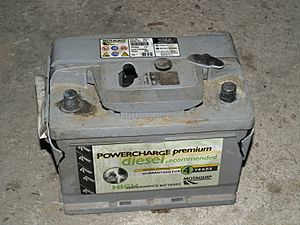
When a battery is charged too much, it can produce hydrogen and oxygen gas. This is called "gassing." These gases can build up inside the battery. If there's a spark, these gases can explode.
An explosion can cause the battery case to burst. It can spray acid and pieces of the battery. This is very dangerous.
VRLA batteries usually have a valve to release gas if the pressure gets too high. But if the valve fails, pressure can build up.
If you work near batteries, especially car batteries, be careful. Always wear face shields, overalls, and gloves to protect your eyes and skin. Never use goggles alone, as they don't protect your face.
Environmental Concerns and Recycling
Environmental Impact
Lead is a toxic metal. Long-term exposure to even small amounts can harm the brain, kidneys, and hearing, especially in children. The car industry uses a lot of lead for batteries.
While lead recycling is very successful, some lead still ends up in landfills. Also, the process of mining and making lead can release it into the environment.
Scientists are trying to find new battery types. But lead-acid batteries are still popular because they are cheap, even though they are heavy.
Recycling Batteries
Recycling lead-acid batteries is one of the most successful recycling programs in the world. In the United States, almost all lead from batteries is recycled.
However, recycling lead can still cause pollution. It can also harm people if not done safely. It's very important for recycling plants to have good pollution control systems. They need to keep improving to meet safety standards.
Battery Additives
Some people add chemicals like Epsom salts or EDTA to battery electrolytes. They claim these can fix problems like sulfation. However, these treatments are rarely effective.
Epsom salts might slightly reduce internal resistance in a weak battery. EDTA can dissolve sulfate deposits. But once dissolved, this material can't help the battery make power anymore. So, a battery "fixed" with EDTA will likely have a shorter life. Also, leftover EDTA can cause more corrosion inside the battery.
Once the active material falls off the plates, no chemical can put it back. Physical problems like cracked plates or corroded connectors also cannot be fixed with additives.
Corrosion Problems
You might see corrosion on the metal parts of a lead-acid battery. This often looks like white, blue, or green crystals on the terminals.
This corrosion happens for a few reasons:
- Electrolysis: Different metals in the battery terminal and cable connector can react.
- Overfilling: If you put too much water in the battery, liquid can leak out. This liquid can react with the metal parts.
- Acid Fumes: Overcharging can release acid fumes. These fumes can react with exposed metals.
You can reduce corrosion by putting petroleum jelly or a special product on the battery terminals.
See also
 In Spanish: Batería de plomo y ácido para niños
In Spanish: Batería de plomo y ácido para niños
- Automotive battery
- Battery room
- Comparison of commercial battery types
- Dry cell
- History of the battery
- List of battery sizes
- List of battery types
- Silver calcium battery
- UltraBattery


